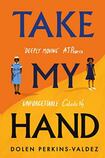
The history of black America, and the reverberations of that history, are familiar ground for US author Dolen Perkins-Valdez. Her first novel, Wench (Amistad Press, 2010) followed four enslaved women who were mistresses to their enslavers in pre-civil war Ohio. Her second, Balm (Amistad Press, 2015), followed migrants seeking healing in post-civil war Chicago.
Her latest novel, Take My Hand, continues in a similar vein, examining horrific events and their aftermath through the story of a nurse in 1970s Alabama, and two sisters in her care who become victims of medical abuse. The first of Perkins-Valdez’s novels to be published in the UK market (which also serves Ireland), it marks an impressive arrival.
Civil Townsend (named as such because, in her father’s words, “we wanted you to be free”) is a 23-year-old black nurse. She has just started her first ever job at the Montgomery Family Planning Clinic. Ostensibly, the “mission” of this clinic is to help disadvantaged black women by allowing them the freedom of planned pregnancy. As part of her role, Civil visits these women in their homes and delivers birth control via a shot in their arm. She believes in the clinic’s mission and its capacity to do good. She has had a clandestine abortion and wants “things to be different” for her patients, through “the miracles” of birth control. But as the book goes on, this mission and Civil’s belief in it quickly unravel and what looked like reproductive freedom is revealed as something far more sinister.
Landmark case
The book is loosely inspired by Relf v Weinberger, a landmark legal case in 1973 Montgomery, Alabama, which dealt with two sisters, aged 11 and 14, who suffered medical abuse at the hands of a federally funded agency. Sparing the specifics to avoid spoilers, it brought to light a much larger scandal and prompted national discussions about medical ethics and racism.
The novel handles a large story with relative ease. Civil’s perspective is an ideal one from which to explore class dynamics and power. The daughter of a doctor, from a family for whom education is a “shield against the kind of disdain that [does] not have the capacity to even conceive of black intellect”, Civil’s challenge lies in coming to terms with her own blind spots and biases. She goes above and beyond to protect a family in her care – two girls, India and Erica, and their father and grandmother, who live in a run-down shanty on a white man’s land – but though she is well-versed in the idea of the “white saviour story”, she remains blind to the idea that her attempts to help this family might be misguided and damaging.
The often-unintended consequences of affirmative action – the idea that “good intentions could be just as destructive as bad ones” – recurs in many guises throughout. In the background, the community where Martin Luther King jnr was once pastor attempts to build upon what he started. Progress occurs, but in the shadow of this progress are people who fall through the cracks, or become further oppressed. Ideologies become warped or are exploited. The iconography of King, and later Barack Obama and John F Kennedy, that recurs throughout the book is tinged with a certain amount of irony. “Every accomplishment starts with the decision to try,” goes one JFK quote, while we wonder if “trying” is what caused the harm to these girls in the first place.
Feeling of finality
Though there is at times a tendency to overexplain what people’s actions or behaviours mean, at a larger structural level the novel is well-balanced. It alternates between present-tense sections in 2016, as Civil embarks on a journey of atonement back to Montgomery, and past-tense sections in 1973, as the story of these girls and the wrong done to them unfolds. This structure allows a feeling of finality to hang over everything – we always know that what is done cannot be undone. It also reinforces one of the book’s main theses: that the past will continue to exert its power over the present, even after supposed change has occurred, and especially if we attempt to forget it.
This is a book about choice, freedom, forgiveness, that pulls threads of history together, and in doing so, catapults its ideas forward. The case of hundreds of black men in rural Alabama who were left untreated for syphilis in a federally funded study, for example, provides a moral touching point as Civil tries to understand what’s going on under her nose. The reader, too, feels compelled to question the ways in which present-day institutions might be failing, or doing wrong by, people. As with all good historical fiction, Take My Hand speaks to the now.












